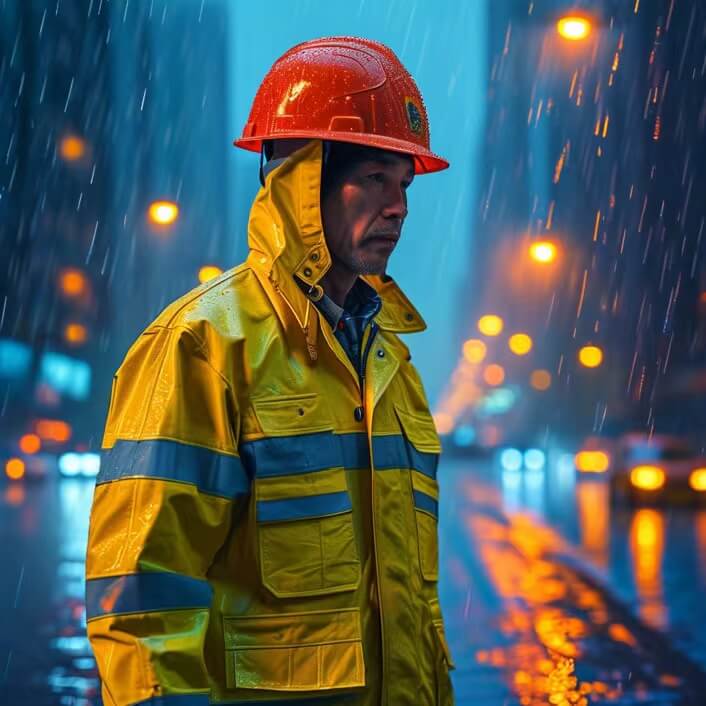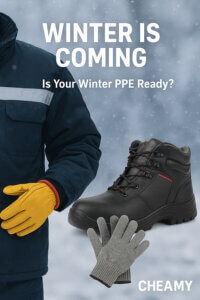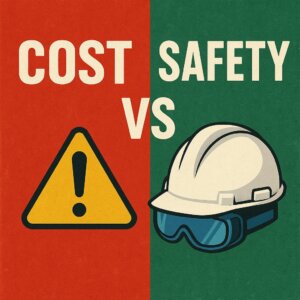Rain transforms workplaces into high-risk zones—slippery surfaces, electrical hazards, reduced visibility, and hypothermia threats surge. Data shows a 40%+ increase in accidents during rainy conditions compared to sunny days . Beyond compliance, quality rain PPE is a lifesaving barrier. This guide unpacks the science behind waterproof protective gear and how to choose it wisely.
⚠️ 4 Major Rain-Related Risks & How PPE Mitigates Them
-
Slips & Falls Wet surfaces exponentially increase fall risks, especially on scaffolds or elevated platforms.
✅ Critical Gear:
- Anti-Slip Safety Boots: Deep-tread rubber soles (EN ISO 20345 certified, slip-resistance >0.4) .
- Full-Body Harnesses: Mandatory for aerial work during rain .
-
Electrocution Water conducts electricity—faulty equipment becomes lethal.
✅ Critical Gear:
- Insulated Gloves & Boots: Voltage-rated (e.g., ≥5kV for low-voltage tasks) .
- Electrical-Hazard (EH) Rainwear: Sealed seams, non-conductive materials .
-
Visibility & Respiratory Hazards Rain obscures vision; dampness amplifies mold/chemical fume exposure.
✅ Critical Gear:
- Anti-Fog Goggles: Dual-pane lenses with hydrophobic coatings .
- Waterproof Respirators: KP/KN masks for oil/non-oily particulates .
-
Hypothermia & Fatigue Wet clothing accelerates body heat loss, causing shivering and impaired judgment.
✅ Critical Gear:
- Breathable Waterproof Jackets: EN 343 Class 3 certified (>13,000Pa water resistance) .
- Thermal-Lined Gloves: Retain dexterity while insulating hands .
🧤 Selecting Rain PPE: The Ultimate Checklist
1. Hi-Vis Rainwear: Visibility Saves Lives
- Standards: Prioritize EN ISO 20471 Class 3 for maximum reflectivity .
- Materials:
- Affordable: TPU-coated Oxford fabric (e.g., WERKVIS WR301 jacket) .
- Premium: Gore-Tex laminates for balanced waterproof/breathability .
- Design: Reflective strips, underarm vents, and dirt-resistant panels (e.g., black shoulder accents) .
Case Study: Workers using EN 343 Class 3 jackets reported 30% less fatigue during 3-hour concrete pours .
2. Safety Footwear: Traction Is Non-Negotiable
- Steel-Toe Rain Boots: PVC construction with puncture-resistant soles (≥1,100N) .
- Drainage Features: Channels to expel water; Ortholite insoles prevent fungal growth .
3. Gloves & Eyewear: Precision Protection
- Gloves: Rubber-coated for grip; cut-resistant layers for metal/glass handling .
- Goggles: Panoramic lenses with side shields to block splashes .
🏢 Corporate Protocols: 3 Layers of Rain Safety Management
- Infrastructure Hardening
- Cover electrical panels; inspect ground-fault systems monthly .
- Install perimeter drains to prevent worksite flooding .
- Operational Adjustments
- Halt outdoor work during thunderstorms or winds >10.8m/s .
- Stagger shift exits to avoid peak-downpour commutes .
- Emergency Kits
- Onsite dryers, thermal blankets, and warm fluids to counter hypothermia .
🔔 Self-Check: Is Your Rain PPE Effective?
- Inspect Daily: Check boot tread depth; test jacket zipper seals .
- Replace Timely:
- Helmets: ≤3 years (fiberglass models) .
- Rainwear: Water resistance drops 30% after 50 washes .
💎 Conclusion
Rain safety gear isn’t bureaucracy—it’s respect for life. One certified PPE suit outweighs a hundred safety posters. Whether you’re an employer sourcing gear or a worker choosing boots: in a storm, your waterproof armor is your survival pod.
“No storm lasts forever. Make sure you outlast it.” — Every worker’s silent promise。








